Joint Properties of Aluminum Alloy and Galvanized Steel by AC Pulse MIG Braze Welding
Abstract
:1. Introduction
2. Materials and Methods
3. Results and Discussion
3.1. Effect of Process Parameters on Wettability
3.1.1. Torch Aiming Position
- When the torch aiming position was −1 mm, dissimilar joining did not occur.
- When the torch aiming position was 0 mm, dissimilar joints were formed with a bead morphology of a right-angle triangle, but there was concavity on the bead surface, where stress concentration resulting in failure occurred during tensile loading. The maximum tensile shear load of dissimilar joints was 6.8 kN.
- In the case of the +1 mm torch aiming position, the bead morphology was similar to that for 0 mm. The maximum tensile shear load was 8.4 kN. Failure occurred at the stress concentration along the fusion line.
- For an aiming position of +2 mm, the amount of the metal deposition significantly increased compared with 0 and 1 mm. The maximum tensile shear load reached 8.5 kN, which was highest among the four torch aiming positions.
3.1.2. Variation in Welding Current and EN Ratio
3.2. Mechanical Property
3.2.1. Tensile Shear Load of Braze-Welded Joints
3.2.2. Fracture Behavior of Braze-Welded Joints
3.3. Microsturucture of Interfical Layer
4. Conclusions
- Among the process parameters, the torch aiming position can play an important role in terms of spreadability and wettability. When the torch aiming position was 2 mm, the amount of metal deposition significantly increased. The maximum tensile shear load of dissimilar braze-welded joints reached 8.5 kN.
- At a fixed welding current, when the EN ratio increased, the filler wire was directly heated and further resulted in a higher metal deposition because the wire melting speed increased.
- The dissimilar braze-welded joints fabricated at a welding current of 70 A with different variations in EN ratio ranging from 0 to 20% significantly increase the tensile shear load. The maximum tensile shear load was 8.8 kN at a welding current of 70 A with an EN ratio of 20%.
- τ5-Fe2Al7Si IMC was mainly formed at the joint interface. The IMC layer thickness decreased with EN ratio because the heat input to the base metal decreased with EN ratio. A thin IMC layer significantly contributed to the higher fracture load of dissimilar braze-welded joints.
Author Contributions
Funding
Institutional Review Board Statement
Informed Consent Statement
Data Availability Statement
Conflicts of Interest
References
- Yagati, K.P.; Bathe, R.N.; Rajulapati, K.V.; Rao, K.B.S.; Padmanabham, G. Fluxless arc Weld-Brazing of Aluminum Alloy to Steel. J. Mater. Process. Technol. 2014, 214, 2949–2959. Available online: https://www.sciencedirect.com/science/article/pii/S0924013614002404 (accessed on 5 July 2014). [CrossRef]
- Zhang, H.; Liu, J. Microstructure Characteristics and Mechanical Property of Aluminum Alloy/Stainless Steel Lap Joints Fabricated by MIG welding-brazing process. Mater. Sci. Eng. A 2011, 528, 6179–6185. Available online: https://www.sciencedirect.com/science/article/abs/pii/S0921509311004679 (accessed on 21 April 2011). [CrossRef]
- Kim, Y.; Park, K.Y.; Lee, B.Y. A Study on the Dissimilar Metal Joining of Aluminum to Steel Using the Arc Heat Source (Ⅱ)—Mechanism of Dissimilar Metal Joining. J. Weld. Join. 2018, 4, 13–22. Available online: https://www.researchgate.net/publication/327188716_A_Study_on_the_Dissimilar_Metal_Joining_of_Alumnum_to_Steel_Using_the_Arc_Heat_Source_II_-_Mechanism_of_Dissimilar_Metal_Joining_ (accessed on 23 August 2018). [CrossRef]
- Murakami, T.; Nakata, K.; Tong, H.; Ushio, M. Dissimilar Metal Joining of Aluminum to Steel by MIG Arc Brazing Using Flux Cored Wire. ISIJ Int. 2003, 43, 1596–1602. Available online: https://www.jstage.jst.go.jp/article/isijinternational1989/43/10/43_10_1596/article (accessed on 14 April 2003). [CrossRef] [Green Version]
- Kim, D.C.; Park, H.J.; Kang, M.J. Principle and Characteristics of AC Pulse MIG Welding. J. Weld. Join. 2008, 26, 548–551. Available online: https://www.researchgate.net/publication/264102018_Principle_and_Characteristics_of_AC_Pulse_MIG_Welding (accessed on 13 June 2008). [CrossRef] [Green Version]
- Park, H.J.; Rhee, S.H.; Kang, M.J.; Kim, D.C. Joining of Steel to Aluminum Alloy by AC Pulse MIG Welding. Mater. Trans. 2009, 50, 2314–2317. Available online: https://www.jstage.jst.go.jp/article/matertrans/50/9/50_M2009105/_article (accessed on 24 September 2009). [CrossRef] [Green Version]
- Cho, S.M.; Kim, T.J.; Lee, C.J.; Lim, S.L.; Kong, H.S.; Kim, K.J. Design and Output Characteristic of AC Pulse Current for MIG Welding of Al Sheet. J. Weld. Join. 2003, 21, 187–193. Available online: https://scienceon.kisti.re.kr/srch/selectPORSrchArticle.do?cn=JAKO200311921620313&dbt=NART (accessed on 17 April 2003).
- Cho, S.M.; Kong, H.S. The Arc Brazing by Variable Polarity AC Pulse MIG Welding Machine. J. Weld. Join. 2003, 8, 56–62. Available online: http://e-jwj.org/journal/view.php?number=499248 (accessed on 25 August 2003).
- Kang, M.J.; Kim, C.H. Joining Al 5052 Alloy to Aluminized Steel Sheet Using Cold Metal Transfer Process. Mater. Des. 2015, 81, 95–103. Available online: https://www.sciencedirect.com/science/article/abs/pii/S0261306915002824 (accessed on 18 May 2015). [CrossRef]
- Lin, S.B.; Song, J.L.; Ma, G.C.; Yang, C.L. Dissimilar metals TIG welding-brazing of aluminum alloy to galvanized steel. Front. Mater. Sci. 2009, 3, 78–83. [Google Scholar] [CrossRef]
- Niu, S.; Chen, S.; Dong, H.G.; Zhao, D.S.; Zhang, X.S.; Guo, X.; Wang, G.Q. Microstructure and properties of lap joint between aluminum alloy and galvanized steel by CMT. J. Mater. Eng. Perform. 2016, 25, 1839–1847. [Google Scholar] [CrossRef]
- Lin, J.; Ma, N.S.; Lei, Y.P.; Murakawa, H. Shear strength of CMT Brazed Lap Joints between Aluminum and Zinc Coated Steel. J. Mater. Process. Technol. 2013, 213, 1303–1310. Available online: https://www.sciencedirect.com/science/article/pii/S092401361300071X (accessed on 4 March 2013). [CrossRef]
- Su, Y.C.; Hua, X.M.; Wu, Y.X. Quantitative Characterization of Porosity in Fe/Al Dissimilar Materials Lap Joint Made by Gas Metal Arc Welding with Different Current Modes. J. Mater. Process. Technol. 2014, 214, 81–86. Available online: https://www.sciencedirect.com/science/article/pii/S0924013613002458 (accessed on 4 March 2013). [CrossRef]
- Milani, A.M.; Paidar, M.; Khodabandeh, A.; Nategh, S. Influence of Filler Wire and Wire Feed Speed on Metallurgical and Mechanical Properties of MIG Welding–Brazing of Automotive Galvanized Steel/5754 Aluminum Alloy in a Lap Joint Configuration. Int. J. Adv. Manuf. Technol. 2016, 82, 1495–1506. [Google Scholar] [CrossRef]
- Kim, Y.; Kim, C.H.; Lee, B.Y. A Study on the Dissimilar Metal Joining of Aluminum to Steel Using the Arc Heat Source (Ⅲ)—Static Strength and Fracture Behaviors. J. Weld. Join. 2018, 36, 23–35. Available online: https://www.researchgate.net/publication/327188609_A_Study_on_the_Dissimilar_Metal_Joining_of_Aluminum_to_Steel_Using_the_Arc_Heat_Source_III_-Static_Strength_and_Fracture_Behaviors_ (accessed on 5 August 2018). [CrossRef] [Green Version]
- Laiping, L.; Shanben, C.; Tao, L. The Modeling of Welding Pool Surface Reflectance of Aluminum Alloy Pulse GTAW. Mater. Sci. Eng. A 2005, 394, 320–326. Available online: https://www.sciencedirect.com/science/article/abs/pii/S092150930401439X (accessed on 23 January 2005). [CrossRef]


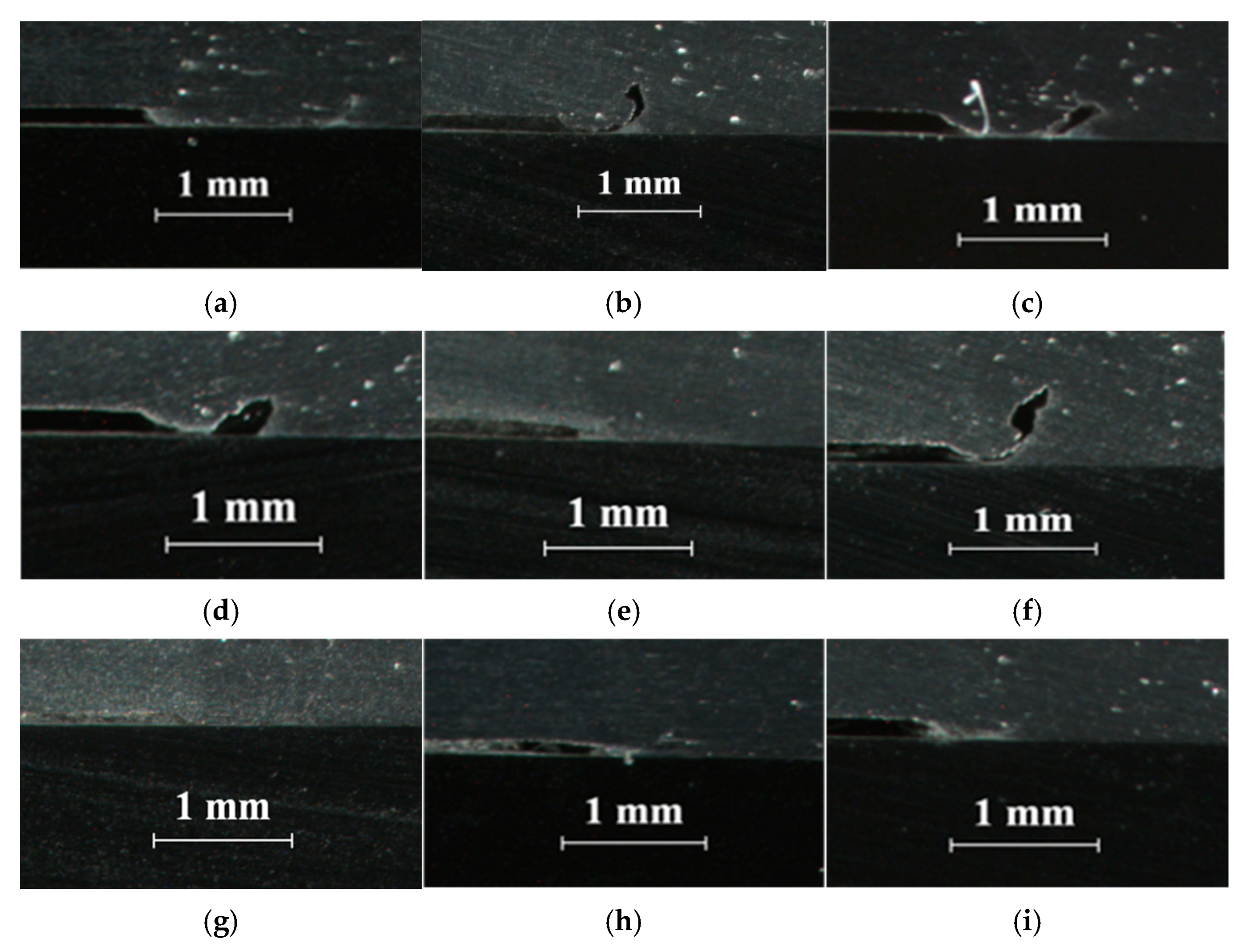

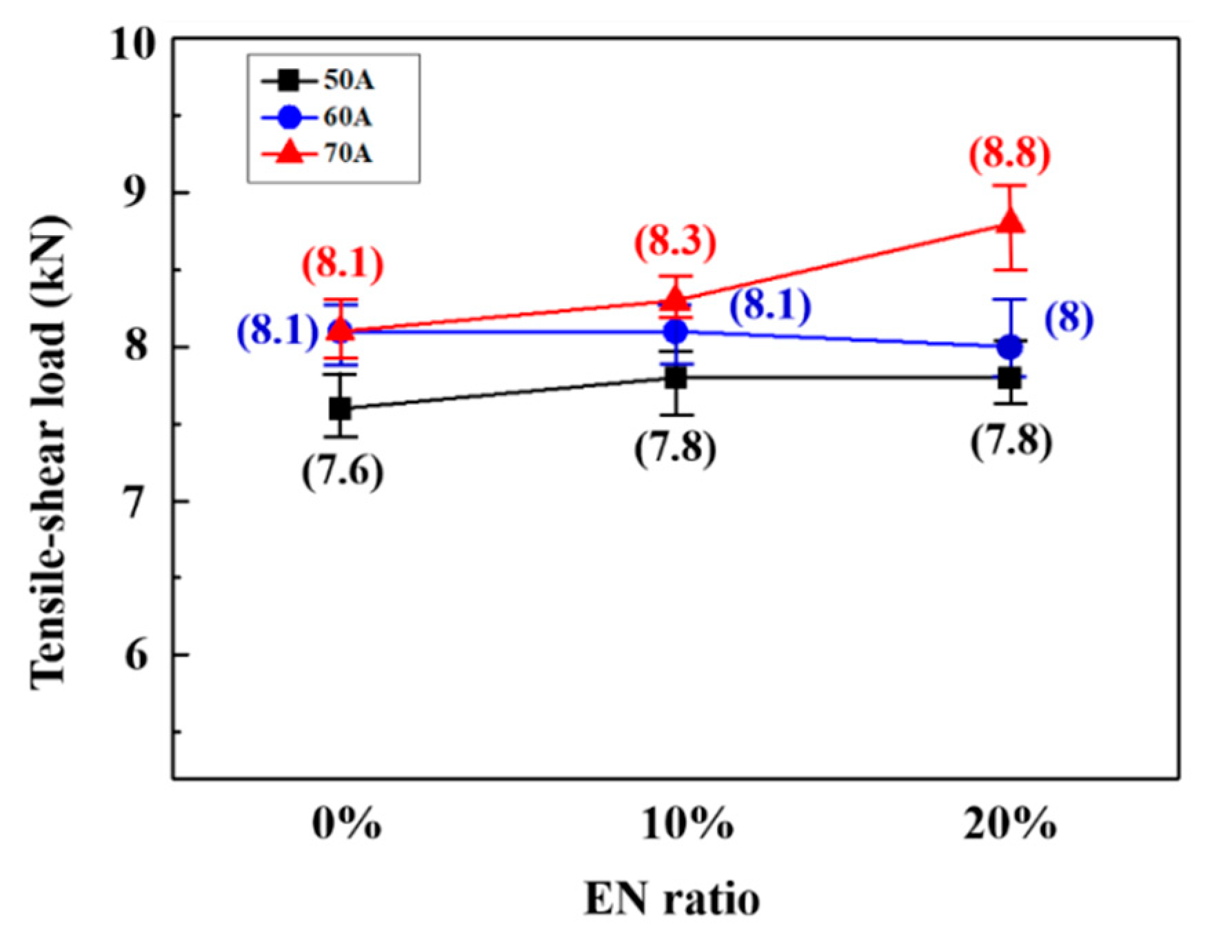
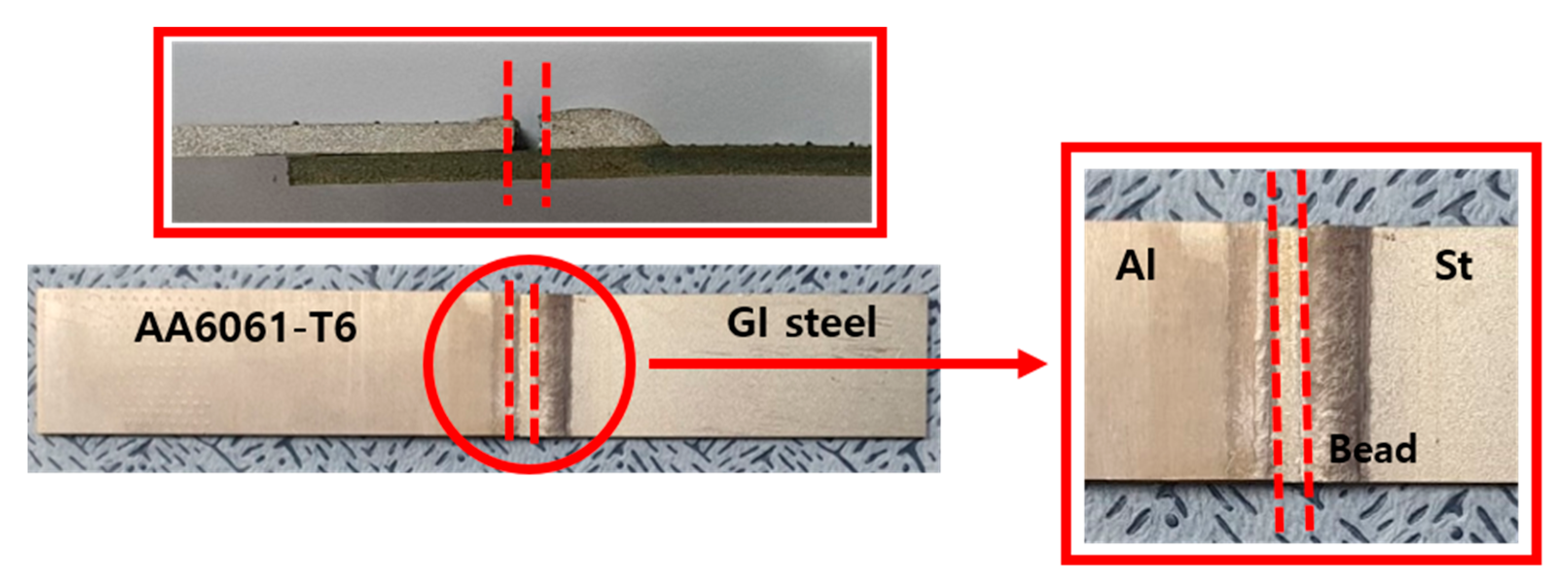

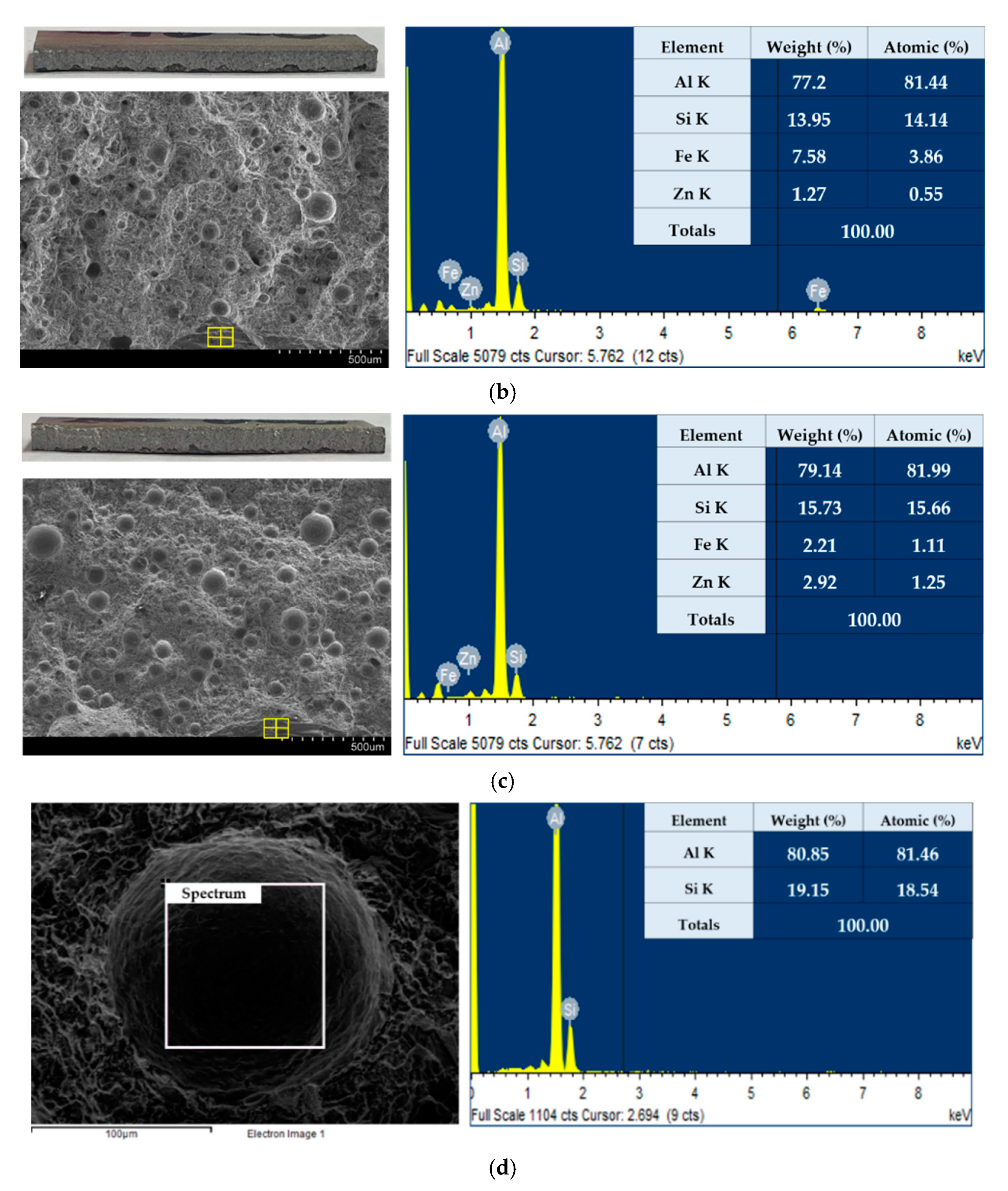
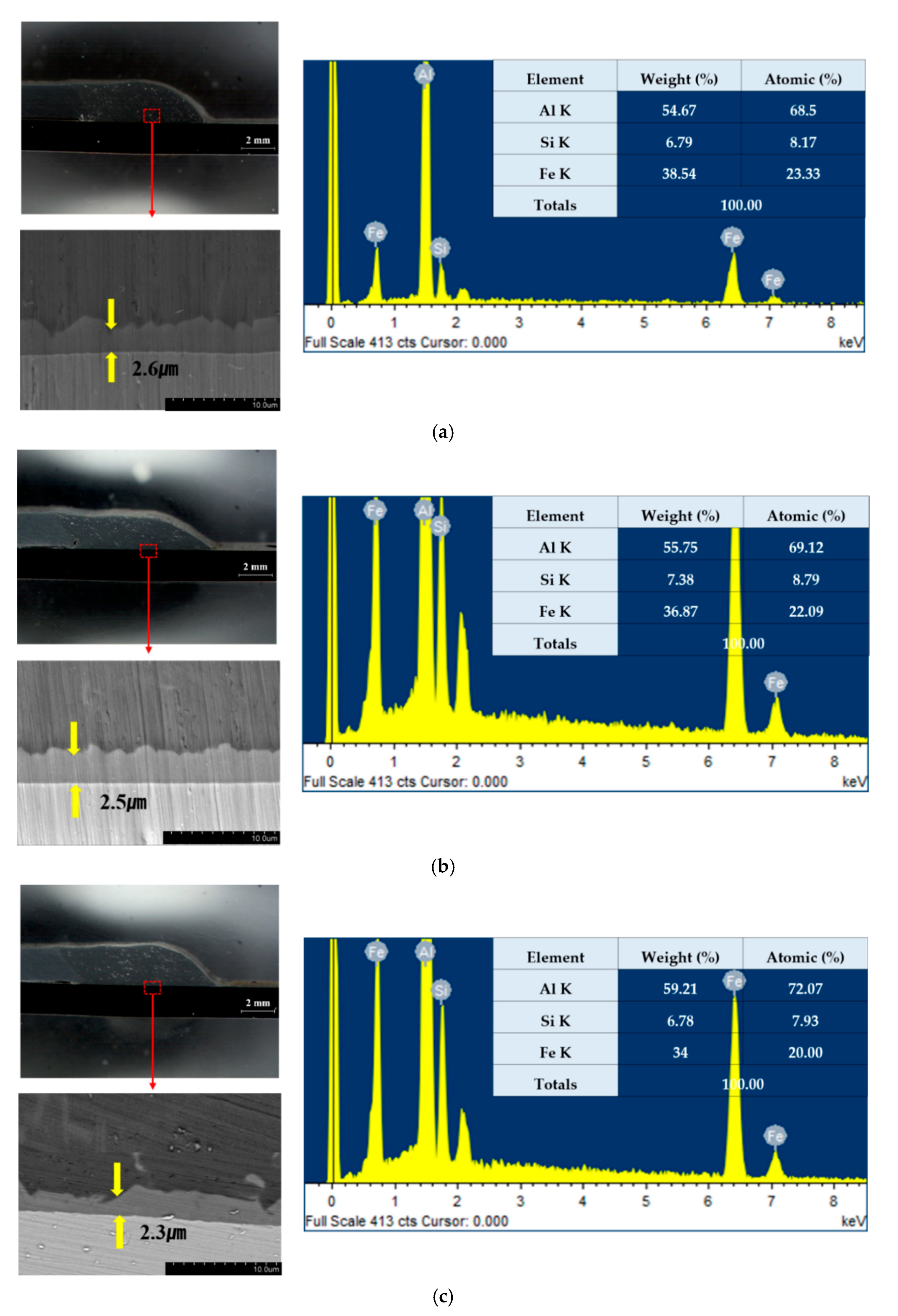
| Materials | Chemical Composition | ||||||||
|---|---|---|---|---|---|---|---|---|---|
| AA6061-T6 | Al | Fe | Si | Mn | Mg | Cu | Zn | Ti | Cr |
| Bal. | 0.7 | 0.4–0.8 | 0.15 | 0.8–1.2 | 0.15–0.4 | 0.25 | 0.15 | 0.04–0.35 | |
| GI steel | Fe | Mn | C | Si | Ti | P | S | ||
| Bal. | 0.18 | 0.032 | 0.02 | 0.001 | 0.014 | 0.005 | |||
| 4047 aluminum wire | Al | Si | Fe | Cu | Mn | Mg | Zn | Be | |
| Bal. | 11–13 | 0.8 | 0.3 | 0.15 | 0.1 | 0.2 | 0.0003 | ||
| Metals | Tensile Strength (MPa) | Yield Strength (MPa) | Elongation (%) |
|---|---|---|---|
| AA6061-T6 | 331 | 301 | 10 |
| GI steel | 371 | 282 | 39 |
| Process Parameter (Unit) | Value |
|---|---|
| Electrode diameter (mm) | 1.2 |
| Welding speed (mm/min) | 500 |
| Work angle/drag angle (degree) | 80/10 |
| Shielding gas | Ar 99.9% |
| Shielding gas flow rate (l/min) | 18 |
| CTWD (mm) | 15 |
| Welding current (A) | 50, 60, 70 |
| Welding voltage (V) | 19 |
| EN ratio (%) | 0, 10, 20 |
| Torch aiming position (mm) | −1, 0, +1, +2 |
| Torch Aiming Position (mm) | Bead Appearance | Cross-Section | Wetting Angle (°) | Wetting Length (mm) |
|---|---|---|---|---|
| −1 |  | Not braze-welded | - | - |
| 0 |  |  | 26.5 | 7.6 |
| 1 |  |  | 21.1 | 7.5 |
| 2 |  |  | 45.1 | 7.4 |
Publisher’s Note: MDPI stays neutral with regard to jurisdictional claims in published maps and institutional affiliations. |
© 2021 by the authors. Licensee MDPI, Basel, Switzerland. This article is an open access article distributed under the terms and conditions of the Creative Commons Attribution (CC BY) license (https://creativecommons.org/licenses/by/4.0/).
Share and Cite
Ro, C.-S.; Kim, K.-H.; Bang, H.-S.; Yoon, H.-S. Joint Properties of Aluminum Alloy and Galvanized Steel by AC Pulse MIG Braze Welding. Appl. Sci. 2021, 11, 5105. https://doi.org/10.3390/app11115105
Ro C-S, Kim K-H, Bang H-S, Yoon H-S. Joint Properties of Aluminum Alloy and Galvanized Steel by AC Pulse MIG Braze Welding. Applied Sciences. 2021; 11(11):5105. https://doi.org/10.3390/app11115105
Chicago/Turabian StyleRo, Chan-Seung, Kyoung-Hak Kim, Hee-Seon Bang, and Hye-Seul Yoon. 2021. "Joint Properties of Aluminum Alloy and Galvanized Steel by AC Pulse MIG Braze Welding" Applied Sciences 11, no. 11: 5105. https://doi.org/10.3390/app11115105






